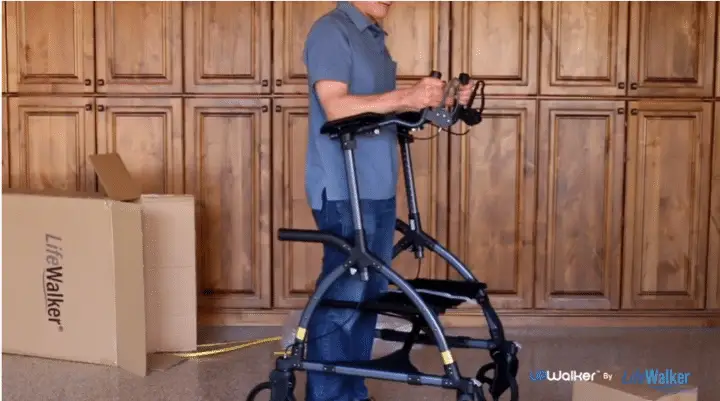Upright walker vs rollator: what’s the difference? Let’s find out!
Contents
Nearly 24% of adults above 65 need some or the other form of mobility aids. We all know the reasons: from arthritis to lower muscle and joint strength and lower back pain.
We should thank technology for developing so many mobility aids such as wheelchairs, walkers, rollators, canes, and others, which help the elderly or physically disabled go about their daily lives with independence.
An Upright Walker is another good innovation in the field of mobility devices. While they might look like a bigger version of a rollator, their use and benefits are much higher. In this article, I will focus on the comparison between an upright walker versus rollator in detail.
What is A Rollator?
A rollator is a mobility device that can have either three or four wheels. If you can walk with a bit of help, but have trouble balancing yourself, then a rollator is a good option.
A rollator also has brakes just below the handles. The user can use the brakes in two different ways:
- The first way is to push the brake down so that your wheels will lock in your desired place, and you can rest for a while on the rollator’s seat.
- The second way is to squeeze the brakes and apply them upward, which will slow down your rollator, especially on inclined surfaces.
Some rollators have storage bags and baskets where you can carry your essential items with you. You can adjust the handlebars according to your preferences.

If I talk about the weight capacity, then an average rollator can support between 250-300 pounds. Still, some special rollators like bariatric rollators can support a lot of weight, from 350 to even 700 pounds.
The bariatric rollator has a low center of gravity and has stronger material. The low seat enables you to sit down and get up easily without putting pressure on your legs.
Most rollators have soft wheels that can quickly roll on most surfaces. Some have larger rear wheels, which helps improve balance and reduces the chances of a rollator tipping over. You can walk a fair bit of distance with a rollator.
You may also like What is the Lightest Weight Rollator Walker?
What Is Upright Walker?
The upright walker is an up-gradation of your traditional rollator walker. An upright walker has elbow pads and height-adjustable handlebars that you can raise to your chest level, which means you do not have to bend or hunch to walk while using them.
There is a height adjustment tube that you can use to adjust the height of the upright walker or the armrests according to your preferences.
Upright walkers have four wheels, all of which are large. The large size of the wheels lets you smoothly glide on any surface. Upright walkers also have brakes by which you can stop your up walker in any desired location.

Just like a rollator, you will find a moveable seat where you can sit and rest for a while, or you can even ask a friend to push you for some time, just like a wheelchair. It’s a good option if you are prone to getting tired easily, such as having a heart condition.
Some upright walkers come with accessories like a beverage holder where you keep your water or coffee, or even a personal bag where you can keep some essential items you may need while walking.
You may also like Best Rollator Walker for a Tall Person
Upright Walker vs Rollator
Although the upright walker and rollator look almost identical, they offer a very different experience to users. Let me compare an upright walker vs. rollator in detail.
#1. Posture
In an upright walker, you always walk in an upright position. You don’t have to lean forward to walk on pavements. So, it will not put pressure on your spinal cord or other joints. An upright walker will relax your joints, and you will feel more active.
But in a rollator, you have to hunch down to walk on pavements. So, after walking for a prolonged period, you may suffer from severe back problems. An incorrect posture can also cause the ligaments on your spinal cord to stretch beyond their standard limit or may strain your spinal disc. As a result, you may experience severe pain in your back, and you might even suffer such problems as spinal stenosis or sciatica.
#2. Forearms
The design of the up walker is such that you can keep not only your hand but also your forearms properly. You don’t have to lift your forearms while walking.
One can easily adjust the armrests according to his preferences by pushing the height adjustment tube. So, an upright walker does not put pressure on the joints of your hand and wrist. If you have arthritis in your hands, this can be very important.
But in the rollator, you don’t have armrests. That’s why walking through the rollator puts pressure on the joints of your hand and may put pressure on your hand. So, you will get tired very soon.
#3. Cost
The Upright walkers are slightly more expensive in comparison to rollators. You might find a rollator walker for as cheap as even fifty dollars, but an upright walker will cost you at least $150. If you are on a fixed income, you might find it challenging to afford an upright walker. Fortunately, there are many options to rent upright walkers.
#4. How Much You Can Walk
With an upright walker, you can walk more because walking upright will not tire you down quickly.
Remember that no medicine can treat your joint pain because it is an outcome of a natural loss of cartilage due to old age. That is why you need to walk as much as possible to keep your joints and muscles active.
An upright walker can help you walk more, thus helping you keep the knee and heel joints active. With a rollator, you can walk independently, but you do tend to get tired soon. You cannot walk as much as you can travel in an upright walker.
#5. Tackling Obstacles
With an upright walker, you can tackle obstacles like bumps on the road or objects on the ground or twisting and turning around small animals. It is so because you are walking in an upright position, and it becomes easier for you to see these objects and save yourself from injury or accidents.
But, in a rollator, you are leaning forward to some extent while walking. So, you may not see the obstacles in front of you as easily, and that may result in accidents or falls on pavements.
#6.Medicare
Both upright walkers and rollators are durable medical equipment but, it’s sad to say that Medicare doesn’t cover the upright walker, while it does cover the rollator.
There are four conditions that a mobility aid needs to satisfy for Medicare to cover it. The conditions are as follows:
- The device should cure your illness.
- A doctor should prescribe the device you use. You need a prescription while submitting for a claim in Medicare.
- Both doctors and suppliers should enroll in Medicare.
- The device should be cost-effective.
Luckily the rollator satisfies all the criteria above, and the people who opt to buy a rollator can claim on Medicare.
But, the people who want to buy an upright walker cannot claim on Medicare because, till now, there are no suppliers of an upright walker who have enrolled in Medicare. That is another reason why Upright walkers are not cost-effective.
You may also like Our Favorite Rollator Walker Accessories
What Should You Choose – An Upright Walker Or Rollator?
Although upright walkers can be expensive and Medicare does not cover them, they are great for your spinal and lower back health. Upright walkers can help keep you away from long-term pains and aches in various parts of your body. Upright walkers give you more active life. So, in my opinion, you should choose an upright walker over a rollator, if it is possible.
If you cannot afford the price of an upright walker, then there are various options available, and you need to choose one of them. You can rent an upright walker from multiple websites like familyrentals.com,independentlyyours.org.
You don’t have to pay upfront money for these rental options. You can pay either on a daily or weekly basis. You can also contact your insurance provider to check whether they cover the upright walker you want to purchase.
You may also like How To Use A Rolling Walker Properly
Conclusion
Mobility aids give you the freedom to move without depending on others. No one wants to stay confined to the four walls of their home, like a prison.
An upright walker and rollator are both comfortable for indoor and outdoor use. But an upright walker allows you to walk in an upright position while walking.
So, upright walkers help keep your lower back and legs pain-free and healthy. After all, health is wealth, and you should not compromise your health just for money.
Even though they may be a bit expensive, upright walkers are a healthier choice over the longer course. After all, treatment for back problems may cost you a lot more! If you are planning to buy an upright walker, you must be wondering how safe are upright walkers. Well, visit our page to know the truth.
Please comment and give your suggestions for this article. If you purchase an upright walker, please post your pictures and write your experience after using an upright walker. I will be happy to read about your experience.



